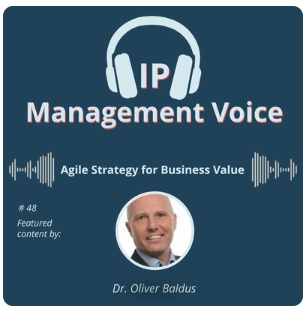Lean IP in Action: How Agile Strategy Turns Patents into Business Value
In episode #48 of IP Management Voice, the focus is on a concept that redefines the role of intellectual property: Lean IP. Borrowing directly from Lean Management, this approach applies principles like eliminating waste, focusing on value, and enabling agility—now to the world of IP portfolios. Dr. Oliver Baldus explains how this lean methodology reshapes how companies think about patents, trade secrets, and trademarks—not as static legal assets, but as dynamic strategic tools. The case study of Siemens serves as a powerful real-world demonstration of Lean IP in action.
👉 Find here an IP Management Lecture on the application of the lean IP approach
👉 Find here the 🔎IP Management Glossary entry on Lean-IP
The Traditional IP Model is Broken
For decades, companies measured the strength of their IP portfolios by sheer volume. The more patents, the better. But as Dr. Baldus argues, this leads to bloated portfolios filled with low-impact filings, high maintenance costs, and unclear strategic direction. Lean IP replaces this quantity-driven mindset with a value-based one: every IP asset must justify its existence by contributing measurable business impact. If it doesn’t support competitive advantage, enable licensing, or protect core technology—it’s trimmed. This is not just about cost-saving; it’s about sharpening focus and improving strategic alignment.
From Compliance Task to Strategic Lever
Traditionally, IP management was a back-office function—reactive, legalistic, and disconnected from product strategy. Lean IP flips that. It embeds IP considerations directly into R&D planning, business model design, and product development. Siemens exemplifies this by integrating its IP experts into innovation teams from the very beginning. This allows them to shape protection strategies that support commercial outcomes—not just legal formalities. The IP team becomes a business enabler, not just a compliance safeguard.
Siemens as a Lean IP Pioneer
 As a global technology leader, Siemens faces a complex challenge: how to manage a massive, diversified IP portfolio across sectors like industrial automation, smart infrastructure, healthcare, and mobility. Instead of applying a one-size-fits-all approach, Siemens tailors its IP strategies to each business unit. In digital industries, where speed is critical, Siemens focuses on agile patent filings, defensive publications, and trade secret protection. In smart infrastructure, interoperability demands a balance between openness and proprietary advantage—leading to strategic engagement in patent pools and standards bodies. In medical devices, Siemens Healthineers prioritizes robustness and long-term value, filing fewer but higher-quality patents to secure lengthy ROI cycles.
As a global technology leader, Siemens faces a complex challenge: how to manage a massive, diversified IP portfolio across sectors like industrial automation, smart infrastructure, healthcare, and mobility. Instead of applying a one-size-fits-all approach, Siemens tailors its IP strategies to each business unit. In digital industries, where speed is critical, Siemens focuses on agile patent filings, defensive publications, and trade secret protection. In smart infrastructure, interoperability demands a balance between openness and proprietary advantage—leading to strategic engagement in patent pools and standards bodies. In medical devices, Siemens Healthineers prioritizes robustness and long-term value, filing fewer but higher-quality patents to secure lengthy ROI cycles.
👉 Find here the Siemens Case Study on Lean IP application by Oliver Baldus
Granular Portfolio Management in Practice
A core part of Siemens’s Lean IP success lies in its granular, continuous portfolio management. Assets are not just filed and forgotten. Each one is regularly evaluated for business relevance. Low-value or obsolete patents are actively pruned to reduce cost and redirect resources. Strategic assets are expanded, licensed, or defended. Siemens applies Freedom-to-Operate analyses to prevent legal conflicts, uses white spot analyses to discover unclaimed innovation areas, and tracks competitor behaviour using patent analytics. These tools help them act—not just react—in dynamic markets.
Aligning IP Strategy with Business Objectives
Lean IP insists on tight alignment between IP activities and broader corporate goals. Strategic IP management asks: where is the business going? Value-oriented IP management follows with: how does each asset help get us there? This dual perspective ensures IP portfolios are not managed in isolation but in direct connection with revenue generation, market access, and strategic control. Siemens’s long-term view of mobility systems or its layered protection of AI solutions both reflect this tight integration between IP and business strategy.
👉 Find here a deep dive on IP Strategy at the digital IP lexicon 🔗dIPlex
The Cultural Shift: From Quantity to Purpose
Implementing Lean IP requires a major cultural shift. Many companies still view patents as prestige assets or insurance policies. But the Lean IP model demands constant evaluation, tough decisions about pruning, and a relentless focus on value. At Siemens, this culture is supported by cross-functional collaboration—between legal, R&D, and business teams—and by consistent training and process integration. The result is a portfolio that is lean, adaptable, and strategically potent.
Responding to Emerging IP Challenges
Lean IP also provides a framework to tackle modern IP complexities. For software and AI, Siemens uses mixed protection models—patents where viable, trade secrets where confidentiality is key, and defensive publications to prevent blocking by others. In highly regulated sectors like medical tech, Lean IP helps ensure that only the most robust, strategically aligned patents are pursued. For ecosystems like smart infrastructure, Siemens uses Lean IP to manage the tension between openness and protection, ensuring market participation without sacrificing core differentiation.
Tools That Make Lean IP Work
Dr. Baldus outlines several critical tools that support Lean IP execution. These include:
- Patent portfolio audits and pruning schedules
Regular audits ensure that every patent in the portfolio continues to support current business goals and market relevance. Pruning schedules allow companies to eliminate low-value or obsolete patents, reducing maintenance costs and focusing resources on impactful IP assets. - Competitive intelligence and patent analytics
By analysing competitor patent activity, companies gain insights into emerging technologies and potential threats. These analytics help shape strategic decisions, such as where to invest in R&D or how to position new offerings in the market. - White spot mapping to identify innovation opportunities
White spot mapping reveals unclaimed areas in the patent landscape that may represent fertile ground for future innovation. Targeting these gaps allows companies to develop unique solutions with less risk of infringement and higher potential for differentiation. - Freedom-to-operate analyses before product launches
Freedom-to-operate (FTO) checks help ensure that a new product won’t infringe on existing third-party patents. Conducting FTO analyses early mitigates legal risk and prevents costly delays or redesigns close to market entry. - Cross-functional planning embedded in the innovation lifecycle
Integrating IP strategy into R&D and product development ensures that protection aligns with commercial and technical objectives. This collaboration fosters smarter filing decisions, better resource allocation, and more agile IP management throughout the innovation process.
These tools transform IP from an afterthought into a source of proactive business insight.
A Model for Any Innovation-Driven Organization
While Siemens is a large enterprise, the principles of Lean IP apply to organizations of any size. The key lessons are:
1 . Measure IP by business value, not volume
2 . Embed IP thinking early in the innovation process
3 . Use IP for both offense (market access, licensing) and defense (exclusivity, litigation prevention)
4 . Regularly prune irrelevant assets to stay agile
5 . Foster collaboration across departments to ensure strategic coherence
For startups, this might mean prioritizing a few high-impact filings. For SMEs, it might involve monetizing existing patents or identifying underutilized trade secrets. For large companies, it means systematizing IP strategy across divisions.
Conclusion: IP as a Dynamic Business Tool
Episode #48 of IP Management Voice makes a compelling case: IP must evolve. In fast-moving industries, a static, compliance-driven IP strategy is no longer enough. Lean IP provides a smarter, more responsive framework—one that treats IP as an active lever for business value, not just legal protection. By following the Siemens model, companies can ensure their innovation is protected, their resources are optimized, and their competitive edge is secured.



